Sustainability: Batteries & Solar | Water | Heating
Batteries | Consumption | Battery Recharging | Solar Charging | How Long Without Sun? | Alternate Charging Options | The Bottom Line
-
- See also: Lithium upgrade | Install a battery monitor | Install an inverter | 12V Basics
- Portable Power: Portable 12V Power & Fridge Options >>>
2025 – Going Lithium
But things are changing! We are in a transition period. Please consider the discussion below relating to the two types of Campervan & RV batteries as background reading, or legacy information for those considering an upgrade of their existing battery installations. If installing batteries in a Campervan or Motorhome today, the ONLY option to consider is Lithium (Lithium Iron Phosphate – LiFePo4). Lithium batteries are still more expensive than AGM batteries, but the weight and performance of Lithium batteries makes them a must-have for portable 12V power, given that they are now becoming more affordable. (Adventure Kings 120Ah Lithium batteries are now regularly on sale for under $350. General feedback in various online forums suggests they are reliable batteries that meet their documented specifications. Adventure Kings also supply 200Ah and 300Ah options, as well as slimline battery modules.) Check out these popular LifePo4 (Lithium) battery options for Campervan and Motorhome installations (or for portable tent/van/canopy camping): |
12V Energy Storage
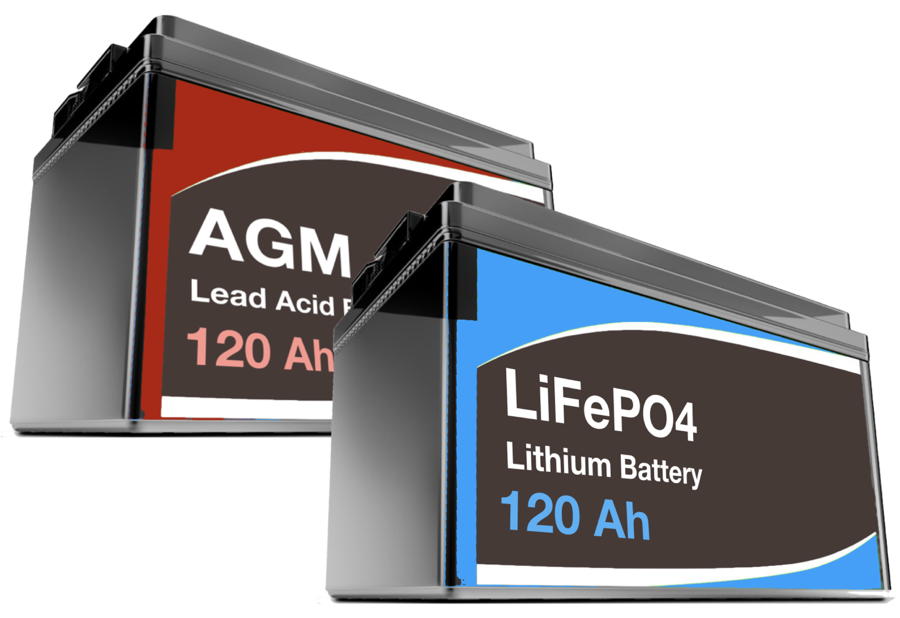 Batteries store the electrical energy that is used to power the 12V electrical appliances in Campervans and Motorhomes.
Batteries store the electrical energy that is used to power the 12V electrical appliances in Campervans and Motorhomes.
A 12V AGM (lead-acid) battery is made up of six (6) internal cells, each producing around 2.1V of electricity.
A 12V LiFePO4 (Lithium) battery comprises four (4) internal cells, each producing around 3.4V of electricity.
These internal cells are connected together (in series) and packaged into one container to produce around 12.6V – 13.6V, from what we know as a single 12V Lithium battery.
Important: ADR Battery Storage Update (2023)
These regulations apply to the installation of electrical equipment in vehicles and relocatable accommodation, and apply to the RV Industry. In relation to battery installation, all batteries installed in ‘habitable living areas’ (ie inside a Campervan, Caravan, or Motorhome) must now be installed in separate storage enclosures. In a similar fashion to the storage requirements for LPG bottles, these storage compartments must be sealed off from the interior living space and provide external ventilation. In addition to the storage location, all Lithium batteries will be required to have a battery management safety system, located not less than 600mm from the battery, designed to prevent over-voltage, over-current and excessive temperature changes. All batteries must be protected from short circuits or over-current situations through the installation of fuses or circuit breakers. All cables connected to the battery terminals must be connected at the terminals provided by the battery manufacturer. No more than four cables can be connected to each battery terminal.
|
Going Deep
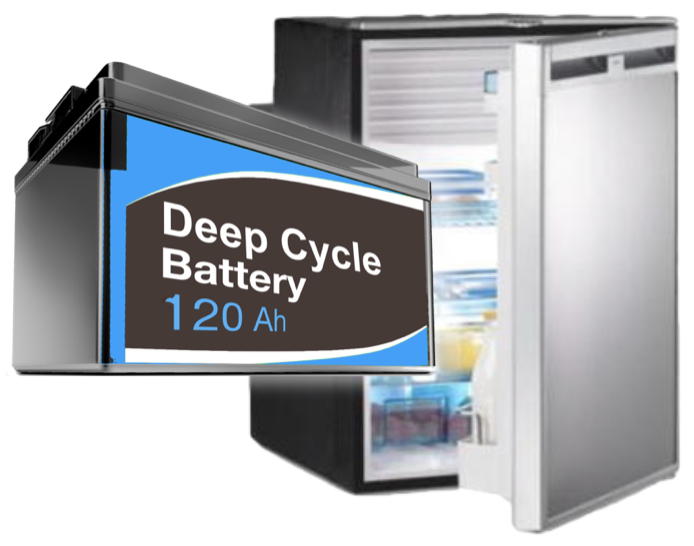 The batteries that are used to power appliances in Campervans and Motorhomes are deep-cycle batteries – which are different from the batteries used to start the engine in your vehicle.
The batteries that are used to power appliances in Campervans and Motorhomes are deep-cycle batteries – which are different from the batteries used to start the engine in your vehicle.
The internal cells in engine starter batteries have thinner plates than those in deep-cycle batteries, resulting in an increased total plate surface area. These batteries are designed to supply a large burst of power over a very short time period, with only a small discharge that is quickly recharged by the vehicle alternator.
Deep-cycle battery cells have thicker plates than those in engine starter batteries. They are designed to provide a steady supply of power over a long period of time. Deep cycle batteries can be more deeply discharged than starter batteries, and recharged many hundreds (or even thousands) of times.
AGM vs Lithium Battery Update
Fast forward to 2025, and the cost / performance figures are now such that Lithium (LiFePo4) batteries are the preferred option – lighter, longer lasting, much better for running inverter appliances, and becoming more affordable. (Checkout Kings 120Ah Lithium batteries for under $400.) If you are starting from scratch in a new fitout, or replacing batteries in an older van, Lithium is the way to go. |
The most popular type of deep-cycle batteries used in Campervans and Motorhomes today are Lithium Iron Phosphate (LiFePo4) batteries. There are still plenty of the older Lead-Acid AGM batteries around, but these will gradually disappear from regular RV use over the next few years….
Absorbent Glass Matt (AGM) batteries have been the most widely-deployed deep-cycle batteries used to power 12V appliances in Campervans and Motorhomes over many years.
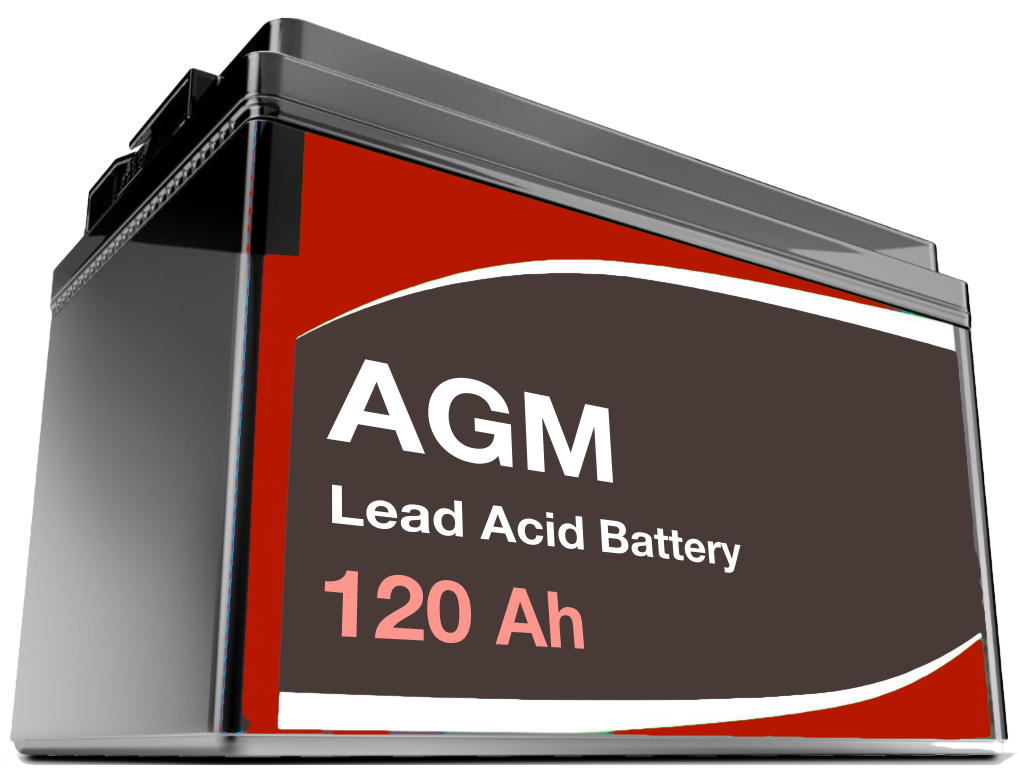 AGM batteries are sealed lead-acid batteries. 12V lead-acid batteries are made up of six internal cells each containing lead and lead dioxide plates ‘immersed’ in acid, causing a chemical reaction that produces electricity.
AGM batteries are sealed lead-acid batteries. 12V lead-acid batteries are made up of six internal cells each containing lead and lead dioxide plates ‘immersed’ in acid, causing a chemical reaction that produces electricity.
In AGM batteries, the electrolyte (ie, the acid) is absorbed into glass fibre mat, rather than having liquid acid sloshing around lead plates in the cells – which is the style of lead-acid battery with which many of us may be more familiar, from experience with car engine starter batteries. These ‘wet’ acid batteries also emit hydrogen gas when charging – which we definitely don’t want inside a Campervan or Motorhome.
AGM batteries are reliable and cost-effective. As a result of their lead content they are also very heavy.
Lithium-Iron-Phosphate (LiFePO4) batteries are the (relatively) new kids on the deep-cycle battery block.
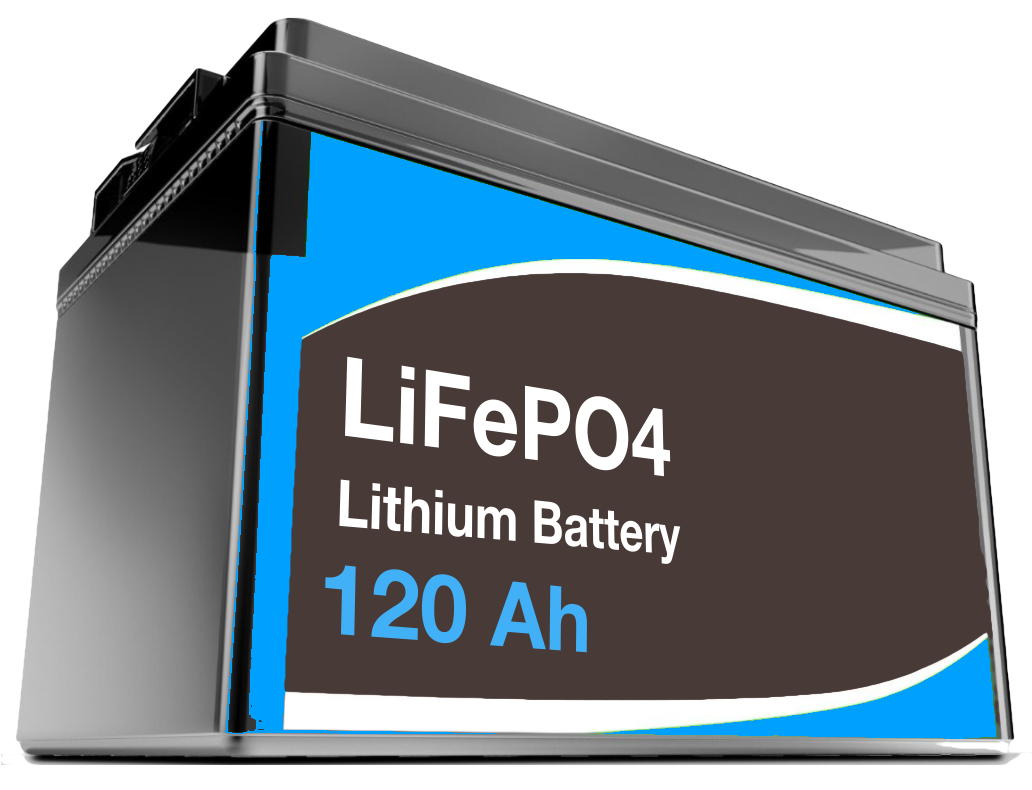 Lithium batteries are quickly becoming the standard battery installed in Campervans and Motorhomes, and have a number of advantages over AGM batteries. (We have replaced our original AGM batteries with 2 x 120 Ah Lithium batteries.)
Lithium batteries are quickly becoming the standard battery installed in Campervans and Motorhomes, and have a number of advantages over AGM batteries. (We have replaced our original AGM batteries with 2 x 120 Ah Lithium batteries.)
The four internal cells in a 12V Lithium battery contain Lithium Iron Phosphate and Graphite plates ‘immersed’ in a chemical cocktail paste of lithium salts and dimethyl carbonate. Good quality Lithium batteries are constructed around prismatic internal cells, while cheaper batteries might have cylindrical cells or pouch cells, or may be constructed with internal components sourced from ‘factory seconds’ suppliers. (See tear-down link below.)
Lithium batteries are less than half the weight of AGM batteries, have deeper discharge limits, recharge more quickly**, and have around four times the life span of AGM batteries (2000+ to 8000+ recharge cycles).
The downside is that they have been up to three times the upfront cost of AGM batteries. Is their performance worth the extra cost? Maybe. But like all new technologies, their price is gradually coming down to the point where they are now considered ‘affordable’. (Update: Kings 120Ah Lithium batteries are now under $350.)
-
- See also: Our Lithium battery upgrade | Battery Recharging
- Video discussion: Kings Lithium performance | Kings Lithium tear-down
Measuring Electricity Supply
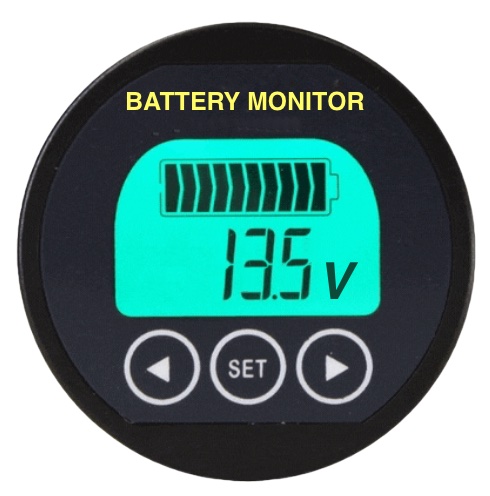 To successfully manage our 12V electricity supply we need to be able to measure the amount of electricity being consumed from our batteries, and consequently the amount of energy supply remaining in the batteries – known as the State of Charge (SoC).
To successfully manage our 12V electricity supply we need to be able to measure the amount of electricity being consumed from our batteries, and consequently the amount of energy supply remaining in the batteries – known as the State of Charge (SoC).
12V electricity supply is measured in Volts and Amps. A neat analogy to help understand these terms is a comparison with water flowing through pipes….
-
- Voltage (measured in Volts) is equivalent to the pressure pushing water through the pipes;
- Current (measured in Amperes, or Amps) is equivalent to the flow rate or the volume of water flowing through the pipes;
- A third factor, Resistance (measured in Ohms), is a measure of how the pipes might restrict the flow of the water – eg, pipes with a small diameter restrict the volume of water flowing through the pipes, compared to pipes with a larger diameter;
- Battery storage capacity (measured in Amp Hours) is equivalent to the amount of water stored in the water tank that is supplying water to the pipes.
In theory, a 100 amp hour (Ah) battery can continuously supply 1 Amp of electrical current for 100 hours, or 2 Amps for 50 hours, 4 Amps for 25 hours, etc, until fully discharged. (Though, as discussed further down the page, your batteries should never be fully discharged – AGM batteries not beyond 50% capacity, and Lithium batteries down to 10% – 20% capacity.)
The voltage supplied by AGM batteries declines in a linear fashion from around 12.8V when fully charged to 12.1V at their maximum 50% discharge.
By comparison, the voltage supplied by Lithium-Iron-Phospate (LiFePO4) batteries remains more constant over a longer period of time, dropping from above 13.5V when fully charged to around 12.9V at their maximum 80% discharge, but then dropping dramatically over the remaining 20% of charge capacity. (From real world experience, our Lithium batteries operate at around 13.1V most of the time, dropping to around 12.8V when ready for a recharge.)
Until recently, the basic battery monitoring device most often installed in Campervans and Motorhomes was a Voltmeter. Once you move to Lithium batteries, a Voltmeter is not quite so useful, due to the small voltage drop of a Lithium battery as it discharges. A more comprehensive Battery Monitor is required to monitor Lithium batteries, providing details not only of the battery voltage, but also of current draw, rates of charge and discharge, and remaining Ah capacity.
-
- See also: Installing a Battery Monitor >>>
State of Charge (SoC)
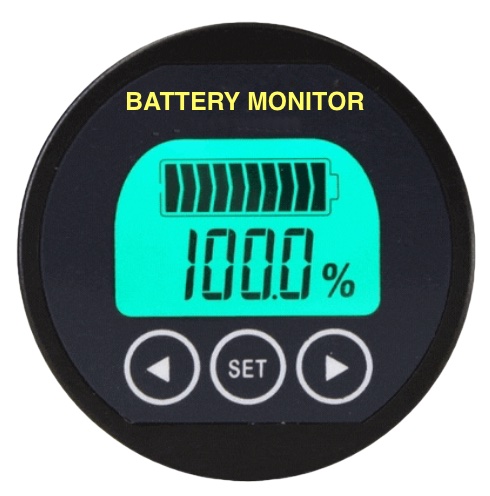 How much energy is left in your batteries? How long before your batteries will no longer be able to supply the energy required to power your 12V appliances?
How much energy is left in your batteries? How long before your batteries will no longer be able to supply the energy required to power your 12V appliances?
The level of energy remaining in a battery at any given time during the discharge / recharge cycle is known as the State of Charge (SoC).
For an AGM battery the SoC can be estimated from a voltage reading, since the battery’s voltage falls in a relatively linear fashion as the level of stored energy declines. This is not so for LiFePO4 batteries, as their voltage output remains relatively constant across a narrow range during their period of discharge. (See graph below.)
| SoC is accurately measured when there is no load on the battery, and there hasn’t been a load for a couple of hours. |
SoC – AGM Batteries
With a load on an AGM battery (eg, fridge running) the voltage will display as less than the actual SoC. When the battery is charging (solar panel input, alternator or 230V charging) the voltage meter will display a higher voltage than the actual SoC.
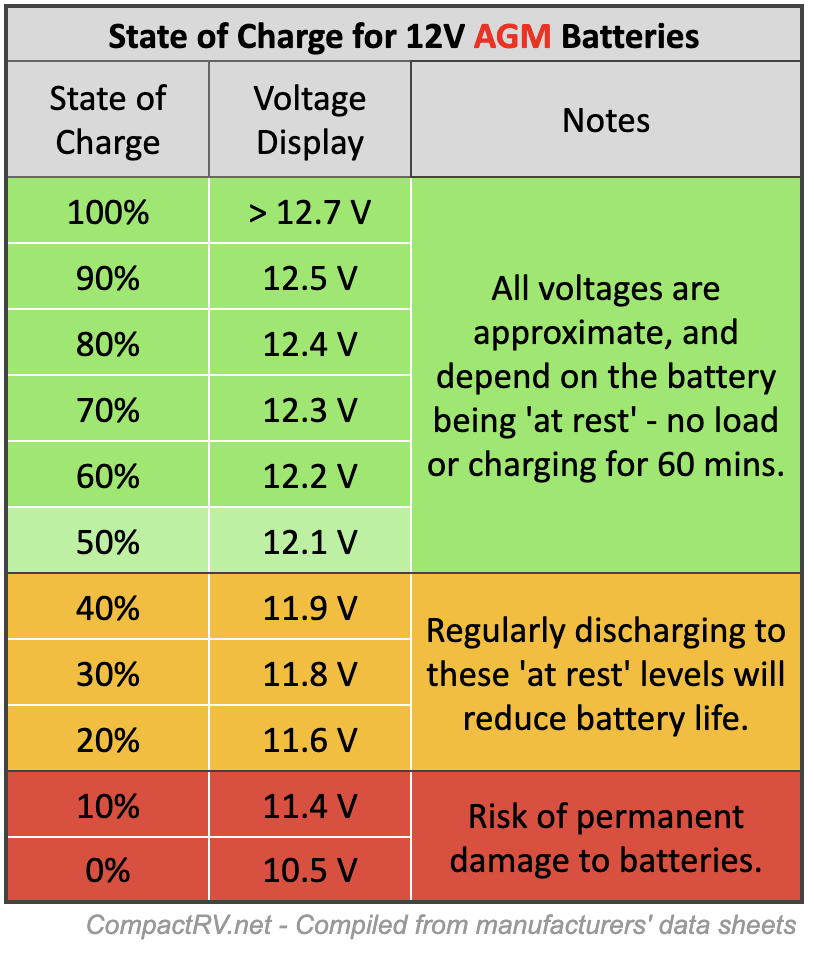 All batteries have discharge/recharge limitations. Deep-cycle AGM batteries’ State of Charge (SoC) shouldn’t be allowed to drop below 50% capacity.
All batteries have discharge/recharge limitations. Deep-cycle AGM batteries’ State of Charge (SoC) shouldn’t be allowed to drop below 50% capacity.
In the case of a 100 Ah AGM battery, this equates to a usable 50 Ah capacity. Discharging below this 50% SoC will reduce the long term life of the battery.
Each time a battery completely discharges (to 50% capacity in the case of AGM batteries) then fully recharges is known as a recharge ‘cycle’. An AGM battery that is allowed to regularly drop below 50% SoC can have its lifetime serviceability reduced to 100-250 recharge cycles, compared to over 500 cycles in a well-maintained charging regime.
An indication of having reached this 50% level of discharge (for an AGM battery) is provided when your digital voltmeter, usually located in an electrical control panel in your van, indicates that stored battery energy has dropped to 12.1 volts when ‘at rest’ – when there are no appliances drawing current and no charging input (see the chart above).

SoC – Lithium batteries
By comparison, Lithium-Iron-Phosphate (LiFePO4) batteries have a completely different charge / discharge profile.
 LiFePO4 batteries (generally referred to simply as Lithium batteries) maintain a relatively steady voltage over their 80% of ‘usable’ capacity.
LiFePO4 batteries (generally referred to simply as Lithium batteries) maintain a relatively steady voltage over their 80% of ‘usable’ capacity.
Due to this steady voltage across the discharge period, the SoC of Lithium batteries is not able to be accurately measured by a simple voltage reading – the voltage drops so little over its 80% discharge period, but then drops steeply beyond the point of 20% remaining charge.
Note: A Lithium battery discharged down to below 10% capacity may become ‘invisible’ to a battery charger, and may need to be reset / recharged using a Lithium jump starter to give it enough charge to make it ‘visible’ again to your regular battery charger.
Coulomb Counting – measuring current flow in and out of the battery – is the preferred mechanism used to measure the SoC of Lithium batteries. Coulomb-counting battery monitors display not only the battery voltage, but also the amps in and out of the battery, the remaining Ah capacity, and the SoC as a percentage of the battery capacity.
AGM vs Lithium – DoD, SoC, cycles, and lifespan comparison
Overall battery life is impacted by continual discharging and recharging – let’s get on top of some related acronyms and jargon……
DoD: Depth of Discharge – a critical factor in the battery charging / discharging process. DoD defines how ‘deeply’ a battery is discharged, as a percentage of it’s fully charged state.
SoC: State of Charge – the percentage of charge remaining at a particular point in the discharge cycle.
Cycle: A full discharge and recharge is referred to as a ‘cycle’.
Lifespan: A battery is capable of a finite number of cycles over its lifetime. This number of cycles is greatly affected by how far a battery is regularly discharged (DoD) before being recharged.
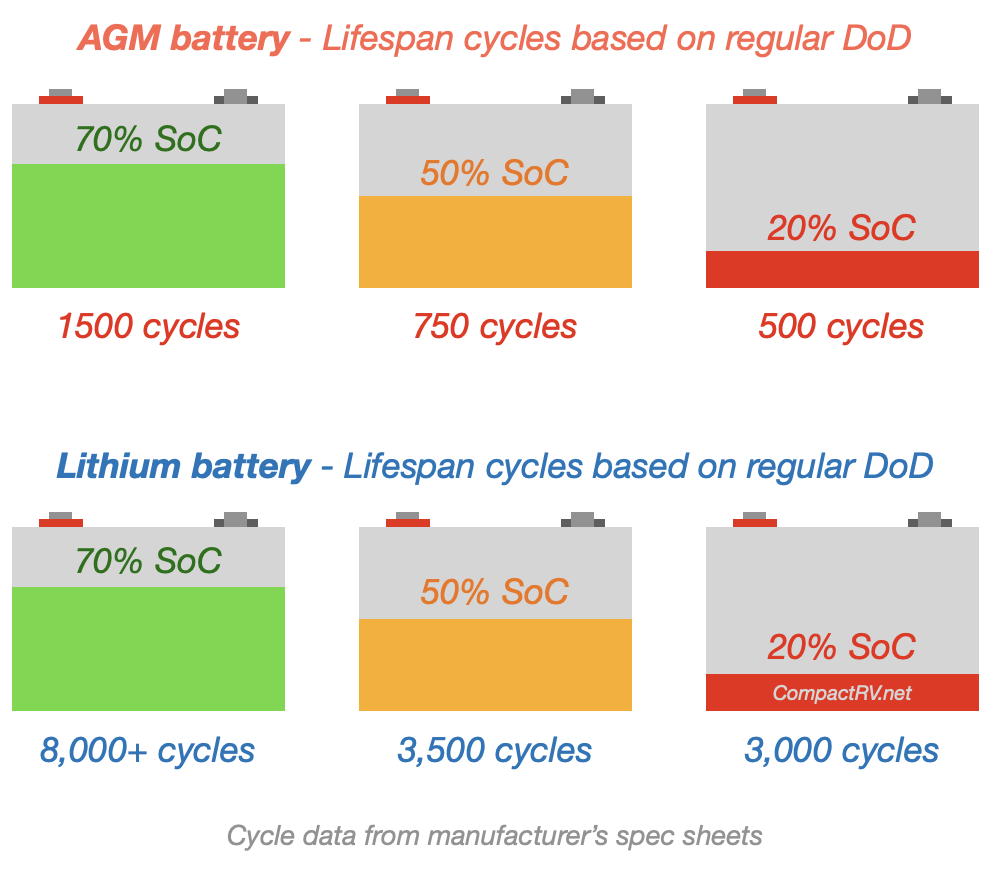
When maintained correctly, Lithium batteries have a longer lifespan (a greater number of recharge ‘cycles’) than AGM batteries. The question is whether or not the extended lifespan is worth the extra upfront cost? (I think it is.)
The same discussion applies to the day-to-day usability of Lithium batteries – LiFePO4 batteries maintain a higher and more consistent voltage output over a longer discharge period.…

-
- Read more: Our Lithium Battery Upgrade | Installing a Battery Monitor
Continuous Discharge Current
This is an important factor if you will be using your battery/s to power 230V AC appliances through an inverter – how many Amps your battery/s can supply as a constant flow of current. (Similar discussion if you are reading this in a country where the mains supply is 110/120V AC – except that the current (I) is doubled in many of the calculations to maintain the same power (P), due the relationships expressed in the formula P=VI.)
 For example, a regular 2-slice toaster draws around 3 Amps when connected to a 230V AC mains power supply. When connected to an inverter this same toaster will pull a constant 70 Amps from your 12V DC battery. (To put this in perspective, residential cabling and power outlets in Australia are generally rated for a maximum current of 10 Amps. Going beyond that will trip a circuit breaker, or ‘blow a fuse’.)
For example, a regular 2-slice toaster draws around 3 Amps when connected to a 230V AC mains power supply. When connected to an inverter this same toaster will pull a constant 70 Amps from your 12V DC battery. (To put this in perspective, residential cabling and power outlets in Australia are generally rated for a maximum current of 10 Amps. Going beyond that will trip a circuit breaker, or ‘blow a fuse’.)
A good quality 120Ah Lithium battery will be able to supply a constant 100 amps. This should not be confused with the higher ‘peak’ discharge current, which can be maintained for up to 5 seconds. This rate of current discharge would consume 100 Ah of capacity in 1 hour – though I wouldn’t like to be actually running an appliance drawing 100 amps from our batteries for an entire hour!
Fortunately your toaster, coffee machine or hair dryer, connected to your battery through an inverter, will only be drawing continuous current at this rate for a minute or two.
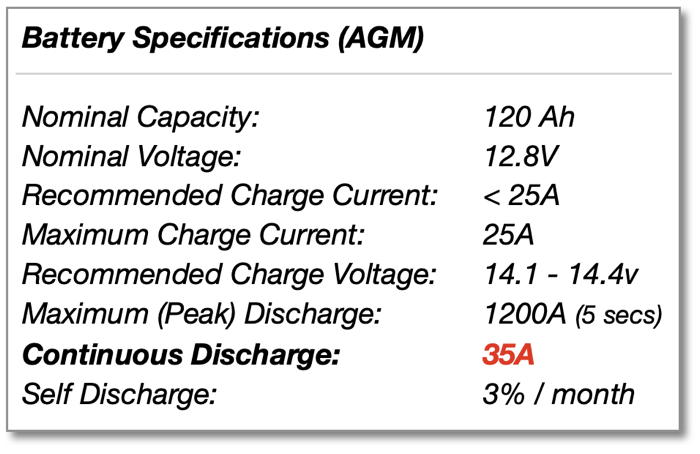 The specifications for AGM batteries often list the ‘peak’ (5 second) current discharge, rather than the maximum continuous current discharge. The peak discharge rate for AGM batteries is usually over 1000 Amps, but you will have to go hunting through spec sheets to find that the maximum rate for continuous current discharge (for a 120Ah AGM battery) is around 30 Amps.
The specifications for AGM batteries often list the ‘peak’ (5 second) current discharge, rather than the maximum continuous current discharge. The peak discharge rate for AGM batteries is usually over 1000 Amps, but you will have to go hunting through spec sheets to find that the maximum rate for continuous current discharge (for a 120Ah AGM battery) is around 30 Amps.
Parallel battery connection can cumulatively increase the continuous current capacity of a battery bank – two batteries connected in parallel provide up to double the continuous current capacity of the individual batteries. I expect that this will be dependent to some extent on the quality of the battery cells, and the specification of the BMS.
Check the specifications for a battery’s continuous/peak current discharge capacity, and the power requirements of any appliances that you may be running through an inverter. (Some appliances also require a short high startup current.)
Read more: Installing an Inverter in our Campervan
Why Lithium?
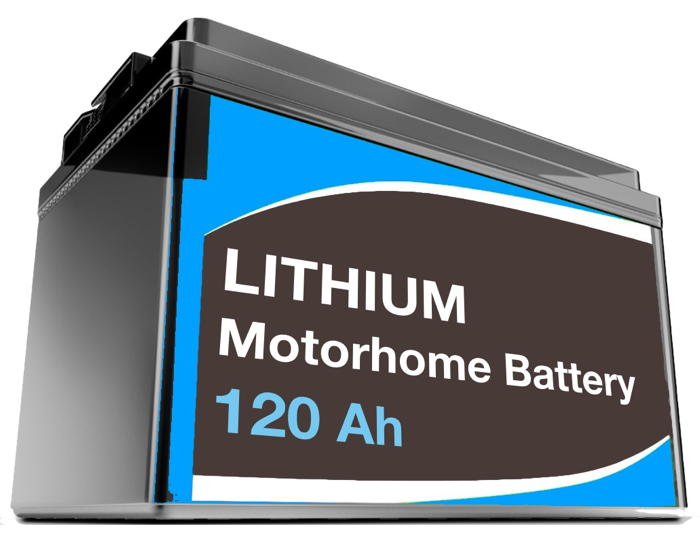 As mentioned above, Lithium-Iron-Phospate (LiFePO4) batteries are the most popular batteries now being installed in Campervans and Motorhomes, in preference to the older AGM batteries.
As mentioned above, Lithium-Iron-Phospate (LiFePO4) batteries are the most popular batteries now being installed in Campervans and Motorhomes, in preference to the older AGM batteries.
Lithium batteries:
-
- are less than half of the weight of AGM batteries;
- maintain a relatively constant voltage over their discharge period;
- have deeper discharge limits (down to 20%);
- are able to sustain a high level of continuous current (important if powering 230V appliances through an inverter);
- are able to recharge more quickly than AGM batteries**;
- have a longer life-cycle (over 2000 recharge cycles);
- are more expensive than AGM batteries.
Lithium batteries have a different charging profile to AGM batteries. Most notably Lithium batteries don’t require a float stage to keep the battery charge ‘topped up’. They also have different voltage and current requirements in the Boost (Bulk) and Absorption stages of the charging process. Your battery chargers (DC-DC and AC-DC) should have a Lithium charging profile to tailor the charging process to suit the chemistry of the battery.
Lithium batteries have built-in electronics known as a battery management system (BMS). This BMS manages the charging of the internal cells, in particular balancing the cells so they all have an equal charge. This is important in Lithium batteries, as one undercharged cell, or one overcharged cell, can impact the performance of the entire battery.
Some suppliers claim that the BMS in their batteries goes beyond cell balancing management, and can adapt the output (voltage and current) from chargers designed for AGM batteries to suit the unique charging requirements of Lithium batteries, making their Lithium batteries “drop-in replacements” for AGM batteries. I take this claim with a grain of salt – though it may take many years to learn if the life span of a Lithium battery has been negatively impacted by the use of a charger with a non-Lithium profile.
The high continuous current capacity of Lithium batteries makes them particularly suitable for powering 230V AC appliances through a power inverter. It is often this continuous current capacity that differentiates cheap Lithium batteries from more expensive batteries.
-
- More information: Lithium Battery Upgrade | Battery Charging | Installing an Inverter
The Parallel UniverseCampervans and Motorhomes often have multiple batteries installed ‘in parallel’ to increase 12V electrical storage capacity.
Read more about connecting Campervan and Motorhome batteries in Parallel and in Series >>> |
Future Battery Options
Another Lithium battery option which we may see in the future is the Lithium-sulfur battery. Still in the experimental lab, these batteries are likely to be much cheaper to produce than Lithium-ion batteries, since they use more easily-sourced raw materials. And they can store much more energy than Lithium-ion batteries. They may also compete with and provide an alternative to Lithium-iron batteries. The one shortcoming of Lithium-sulfur batteries is their overall lifespan – though researchers are busy trying to solve this problem.
The Lead Crystal battery was another contender that showed much promise, at least in theory. This derivation of AGM batteries claimed to be able to be discharged to 0V, have a faster recharge time than lead-acid batteries, and have a lifespan of 18 years. However, these batteries appear to have gone by the wayside (at least here in Australia) as Lithium batteries have become more pervasive in the mass market.
What does it all mean?
The important take-away from the above discussion is that Lithium batteries are the way to go for RV installations. In addition to that one guiding principle, some individual details relating to both Lithium and AGM batteries include….
AGM Batteries
-
- AGM batteries are very heavy – an important consideration in RVs;
- If you have 1 x 100 Ah AGM battery you will have a ‘usable’ electrical storage capacity of 50 Ah – 50% of total capacity;
- If you have 2 x 100 Ah AGM batteries connected in parallel, you will have a total usable electrical storage capacity of 100 Ah – 50% of total capacity.
- The voltage of AGM batteries declines in a linear fashion as the battery discharges;
- Dropping below an AGM battery’s 50% State of Charge may result in the shortening of long-term battery life.
Lithium Batteries
-
- Lithium batteries are less than half the weight of AGM batteries.
- If you have 1 x 100 Ah Lithium battery you will have a usable capacity of 80 Ah – 80% of total capacity.
- If you have 2 x 100 Ah Lithium batteries connected in parallel, you will have a usable capacity of 160 Ah – 80% of total capacity.
- The voltage of Lithium batteries remains relatively constant over their usable discharge period;
- Dropping below 20% capacity may result in the shortening of long-term battery life.
- Dropping below a Lithium battery’s 10% State of Charge may require a special procedure to ‘restart’ the battery.
Charging & Discharging
-
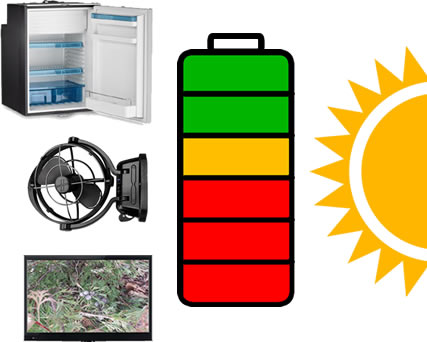 Batteries’ stored electrical energy is drained by 12V appliances. This energy can be restored by electrical current generated by solar panels, the vehicle alternator, or a 230V AC power supply.
Batteries’ stored electrical energy is drained by 12V appliances. This energy can be restored by electrical current generated by solar panels, the vehicle alternator, or a 230V AC power supply.- Charging current must be fed to the batteries through an appropriate battery charger or regulator.
- Lithium batteries have a number of advantages over AGM batteries, including a more constant voltage output, longer discharge period, lighter weight, higher continuous current capacity, much longer life-cycle, and (in some circumstances) faster recharging.
All of which leads to the following questions….
-
- How long can we free camp without an external power supply?
- How long will it take for the 12V appliances in our van to exhaust our batteries’ stored energy capacity?
- Do our recharging facilities have the capacity to top up this depleted energy supply each day?
- Are Lithium batteries worth the expense?
The next section – Appliance Consumption – takes the first step in answering those questions by considering how much electrical current each of our appliances drain from our batteries.
** AGM v Lithium charging rates
AGM batteries can charge at up to 20% of their rated capacity. For a 100 Ah AGM battery this is around 20 Amps. With a high current input (say 40 – 50 amps), Lithium batteries will recharge more quickly than AGM batteries. Lithium batteries will charge up to 95% capacity before tapering off, while AGM battery chargers will begin tapering their charge current at around 70% capacity. However, if you are re-charging your batteries with current feeding in from a 150W solar panel, the charging current is likely to be around 6 Amps. This is well below the potential maximum current input for both Lithium and AGM batteries (50A / 20A), especially when your fridge is probably consuming 3 amps of that solar-generated current.
So, I expect that there will be little noticeable difference in charging times between Lithium and AGM batteries in a typical Campervan or Motorhome environment when the batteries are recharging from a solar panel. Lithium batteries may charge a little faster in this environment, but not by a huge factor. Lithium batteries’ faster charging capacity may be more noticeable when charging from the vehicle alternator, or a 230V AC-DC charger. Our DC-DC charger is supplying 40 amps from the vehicle alternator, even when idling. The lithium batteries can accept this level of charge right up to 95% of capacity, so a few hours driving will recharge the lithium batteries from 40% to nearly ‘full’, which is considerably faster than our previous AGM batteries were able to recharge. |
More information
Lithium batteries…
|
Batteries | Consumption | Battery Recharging | Solar Charging | How Long Without Sun? | Alternate Charging Options | The Bottom Line

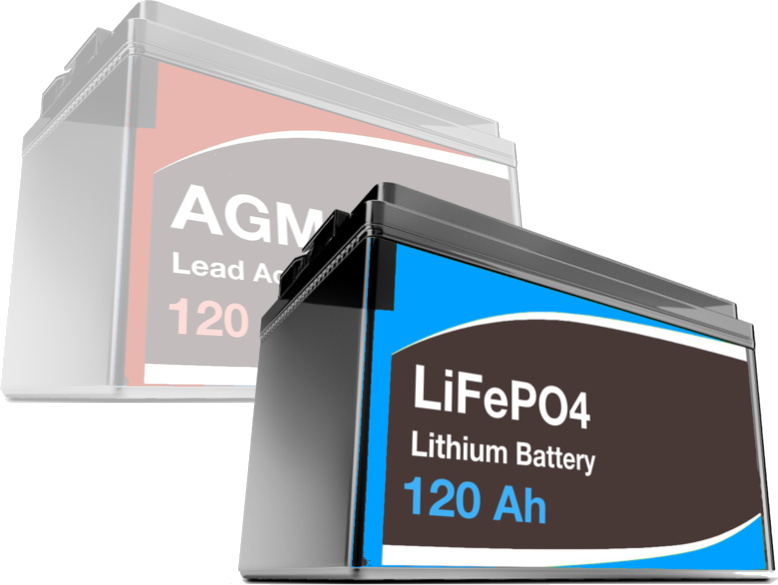 This page was originally written a few years ago, and discusses both AGM and Lithium batteries as viable options to power 12V appliances in Campervans and Motorhomes.
This page was originally written a few years ago, and discusses both AGM and Lithium batteries as viable options to power 12V appliances in Campervans and Motorhomes.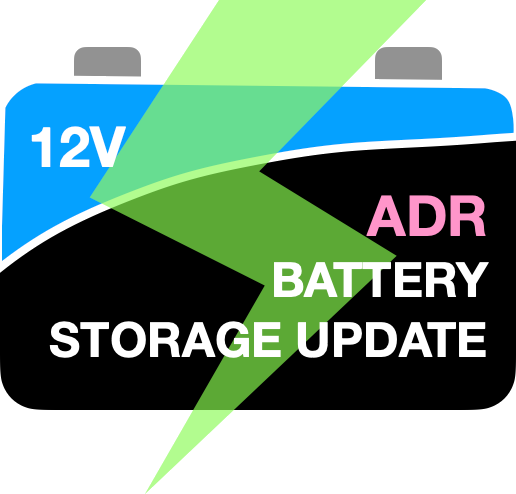 New Australian Design Rules for ‘Connectable Electrical Installations’ were released in November 2022. (Australian Standards AS/NZS 3001.2:2022).
New Australian Design Rules for ‘Connectable Electrical Installations’ were released in November 2022. (Australian Standards AS/NZS 3001.2:2022). When these pages were originally written, AGM batteries were the most widely installed batteries in Campervans and Motorhomes.
When these pages were originally written, AGM batteries were the most widely installed batteries in Campervans and Motorhomes.
 Even when we connect our 200W solar blanket to deliver an additional 8 amps per hour (in good conditions!), we have a total input of 14 Amps. With a fridge drawing 3 of those amps, the net 11 amps is still well short of the peak charging inputs of both AGM and Lithium batteries. (Though there may still be some small benefit for Lithium batteries, as Lithium chargers maintain a constant charge rate up to the battery’s maximum capacity, while AGM chargers taper the charging rate as the battery approaches maximum capacity.)
Even when we connect our 200W solar blanket to deliver an additional 8 amps per hour (in good conditions!), we have a total input of 14 Amps. With a fridge drawing 3 of those amps, the net 11 amps is still well short of the peak charging inputs of both AGM and Lithium batteries. (Though there may still be some small benefit for Lithium batteries, as Lithium chargers maintain a constant charge rate up to the battery’s maximum capacity, while AGM chargers taper the charging rate as the battery approaches maximum capacity.)